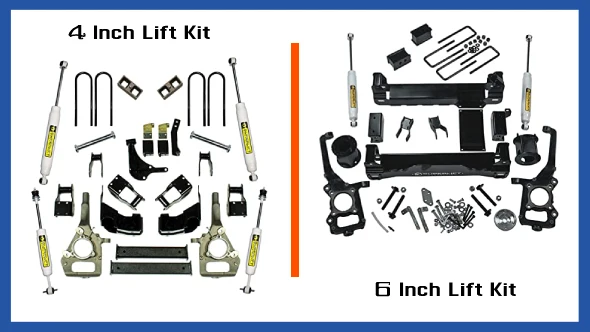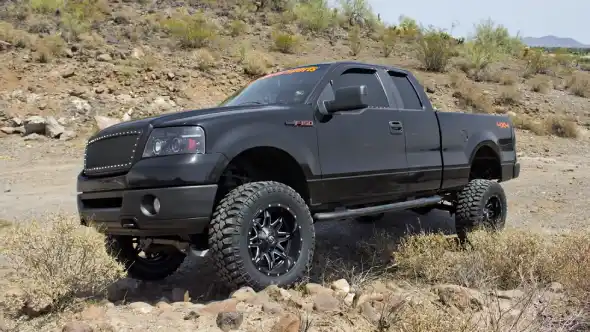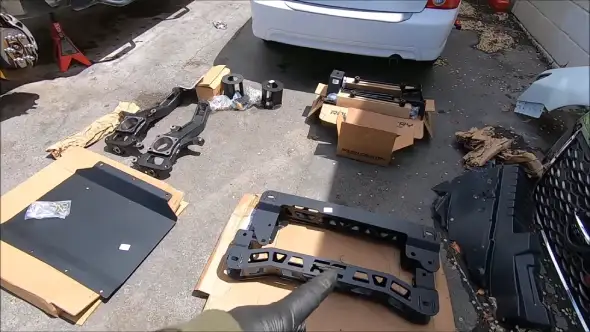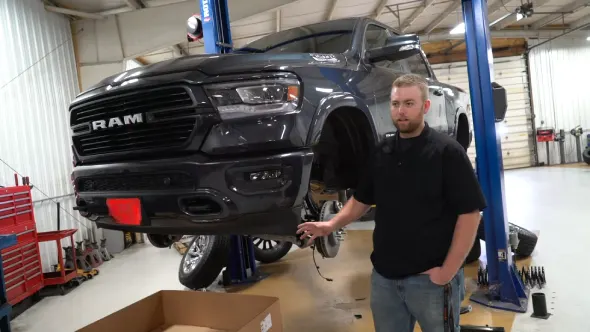Last Updated on May 7, 2023
When customizing your vehicle and giving it a heightened look, improved performance and off-roading capabilities, the right lift kit is essential. The two main options for accessorizing your vehicle are a 4-inch and 6-inch vehicle lift kit.
While both lifts bring many benefits, there are differences between them. A 4-inch lift can offer a moderate height increase with a smoother ride instead of the much taller 6-inch lift kit that offers a more dramatic height boost but results in a harsher ride and higher installation cost.
But before making any decisions about your vehicle lift kit, check local laws for any legal considerations or restrictions that may apply. Today we’ll explore the differences between 4in and 6in lift kits so that you can decide which one is right for you. So let’s get started.
4 Inch Lift Kit VS 6 Inch Lift Kit: Know the Differences

If you want to elevate your vehicle and give it a lift, the two most popular lifts are the 4” and 6” lifts. Knowing these two lifts’ differences can help you decide which is right for you.
Here are a some significant differences to pay attention to:
Lifting Height
The key difference between a 4” lift kit and a 6” lift kit is the height of the lift. A 4-inch lift increases height by four inches, giving your vehicle some extra clearance and allowing for larger tires.
On the other hand, a 6-inch lift raises your vehicle six inches from its original height, making it much higher than with the 4” option. This additional clearance allows for even bigger tires and more off-roading opportunities.
Tire Compatibility
The tire size compatible with each type of kit varies depending on the lifting height needed to safely accommodate them. For instance, a 4 inch lift can support 34-35 inch tires while a 6 inch lift can fit 36” and 37” tires.
To get the most out of these larger tires with either size kit, it’s essential to also consider wheel offset as well as wheel backspacing when doing your calculations before purchase.
Gear Ratio Compatibility
Finding the right gear ratio is essential when installing a lift kit, especially when driving offroad. Different lifts and tires vary in size and weight, so you’ll have to determine if the gear ratio of your vehicle is up to the challenge.
For example, with a 4-inch suspension lift kit and 33-inch tires, a 3.55 gear ratio should be enough. But if you increase the tire size to 34 inches or larger, then aim for higher ratios of 3.73 or 3.91 accordingly.
Ultimately, researching ahead is key for creating optimal engine efficiency for your off-roading adventure.
Suspension Components
Both lifting kits require certain suspension components to be properly installed onto any given vehicle. This includes things like shocks/struts, sway bars/links, control arms/brackets, etc., but their specifications vary based on what type of lifting kit (4″ vs 6″) you choose to go with to meet safety standards.
Higher quality parts are always recommended for better durability over time. Still, if you’re willing to sacrifice some longevity then lower grade parts may also suffice depending on how often they will be used.
Ride Quality
When comparing a 4-inch lift kit with 6-inch lift kit for your vehicle lifting in terms of ride quality, vehicles with a 6-inch lift may have their suspension components further away from the body of the car, resulting in increased vertical travel.
This additional suspension travel helps reduce vibrations and shock from rough terrain and results in a smoother overall ride than a 4-inch lifted vehicle. But this can come at a cost, as more suspension travel requires larger shocks and springs which ultimately adds to the cost of the installation.
Also, although the 6 inch lifted vehicles can handle rougher roads better than their 4 inch counterparts, they will usually still suffer more body roll due to their higher center of gravity compared to those with lower lifts.
Off-Road Performance

For off-roading applications, there is no debate that the 6 inch lifted vehicles have far superior performance over 4 inch lifted cars, since they offer much greater ground clearance allowing them to traverse obstacles more easily without needing modifications.
The increased suspension travel also allows drivers to tackle steeper hills and ditches while remaining comfortable inside the car, which would be impossible with just four inches of clearance.
On top of this, these kits typically come with bigger tires than what is offered in standard sizes for 4×4 vehicles. Traction improves drastically due to their larger contact patch against uneven terrain surfaces.
Garage Space Needs
Installing either lift kit means you’ll need to adjust your garage space requirements accordingly. Since both will necessitate taller storage areas for parking comfortably inside garages or other storage facilities like sheds.
With that said, it is worth noting that if maximum ground clearances are what you aim for, opting for a 6-inch kit will require more height than if you went with only four inches.
Fuel Consumption/Mileage
Regarding fuel consumption/mileage differences between 4-inch lift kits and 6-inch ones, it is essential to note that larger lifts result in heavier suspensions which impact overall drivability and efficiency (in most cases).
Since big wheels increase rolling resistance, cars with bigger lifts consume more gas than those running smaller setups. Hence they often achieve poorer mileage rates than stock vehicles or even four-wheel drive models which have been slightly elevated using shorter lifts instead.
Driving Experience
A 4 inch lift kit gives vehicles an even ride with good handling characteristics on smooth roads. The added height allows vehicles to clear obstacles more easily than stock suspension systems, but it can lead to some body roll when cornering at high speeds.
Meanwhile, a 6-inch lift provides more ground clearance than a 4-inch kit due to its larger size and increased height off the ground but, this can result in a rougher ride on paved surfaces due to its higher center of gravity.
Legal Considerations
When installing any type of lift kit for your vehicle, you must consult local laws about modifications before making any changes or upgrades. This is especially important when considering a 6-inch lift kit, as there may be certain regulations or restrictions about how much you can raise your vehicle.
Also, some states have strict rules regarding tire width requirements when running taller lifts on certain vehicles. Thus, you must double-check that you are within legal limits before moving forward with any installation process.
Installation Cost
The installation cost will vary depending on the make and model of your car and what kind of lift kit you choose. But 4 inch lifts are cheaper than their 6 inch counterparts since they require fewer parts and labor hours during installation.
Furthermore, because 6-inch lifts require more components than 4-inch lifts they also tend to take longer to install. Thus driving up labor costs considerably when performing the upgrade process.
Can a 6-Inch Lift Kit be Installed on Any Vehicle Type?

A 6-inch lift kit can only be installed on a few vehicles such as Jeeps, trucks, and SUVs. This is because these vehicles have more structural robustness than other cars, allowing them to carry additional weight without compromising safety.
Also, many Jeeps, trucks, and SUVs are designed with higher ground clearance from the factory, allowing easier installation of the larger lift components. But even with these vehicles, there can be limitations on the size and scope of a 6-inch lift kit install.
Many smaller SUVs may not be able to handle such a large kit due to an inability to bear the necessary weight or lack of space under the body for mounting all of the parts. Some kits may also require specific suspension lift components that may not work with some models and makes.
What is a 4 Inch Lift Kit Good for?

A 4-inch lift is good for many purposes, depending on the individual’s needs. Most commonly, a 4-inch lift provides additional ground clearance that allows vehicles to traverse more challenging terrain and roads.
When paired with larger tires, a 4-inch lift can provide greater stability while driving off-road and improve overall performance. Also, a 4-inch lift gives vehicles a more stylish and intimidating look that is popular among Jeep owners.
For those looking for improved performance without sacrificing fuel economy or maneuverability, a 4-inch lift kit is an ideal option. A 4-inch lift doesn’t sacrifice fuel efficiency or handling like 6-inch lifts, which require bigger tires and can affect steering angles.
In terms of practical applications, a 4-inch lift kit can be used in numerous scenarios ranging from rock crawling to everyday highway driving. In extreme terrains like mud bogs or rocky trails, installing larger tires under the vehicle typically requires at least four inches of clearance above the tread pattern.
Do 6-Inch Lift Kits Affect Driving?
A 6-inch lift kit affects driving in various ways. To begin with, the lift kit will raise the vehicle up higher off the ground, thus requiring more power to maintain directional control and stability.
This can also cause an increase in body roll due to the higher center of gravity. As a result, drivers may experience reduced handling performance and difficulty negotiating turns due to increased cornering forces.
Also, a 6-inch lift can affect suspension geometry, leading to excessive wear of suspension components if not checked regularly. Furthermore, steering components must be adjusted or replaced to accommodate the new ride height.
The additional height may create a safety risk if the clearance between the tires and wheel wells is insufficient. Drivers need to be aware of these effects before making any modifications to make an informed decision regarding their vehicle’s setup.
Are 6-Inch Vehicle Lift Kits Legal?

The legality of 6-inch vehicle lift kits varies from state to state. While it is generally accepted that such modifications are permissible in most states, some states have more stringent laws.
In California, for example, only five inches of lift is allowed to meet legal standards. In some other states, larger lifts may be allowed within certain parameters. But this varies on a case-by-case basis and should always be verified before making any modifications.
Some states may also require additional safety features on the vehicle if the lift kit exceeds a certain height or tread width. Also, some states (such as Colorado) may not recognize aftermarket lift kits as legal modifications and could impose fines or other penalties if they are discovered.
As with any modification to a vehicle, it is important to check local and state regulations when considering installing a 6-inch vehicle lift kit.
4-Inch or 6-Inch Lift Kit: Make a Confident Investing Decision
After considering all the information provided above, you should now be better equipped to decide whether a 4 or 6-inch lift kit is the right choice. When it comes down to it, it depends on your individual needs.
If you need extra height for certain jobs or legal reasons, a 6-inch lift may be your best option. But if neither of those factors is relevant, a more budget-friendly 4-inch lift could fit your needs just fine.
Ultimately the decision comes down to preference and whether or not it suits your needs. We hope this guide has helped you decide which type of lift is right for you.
